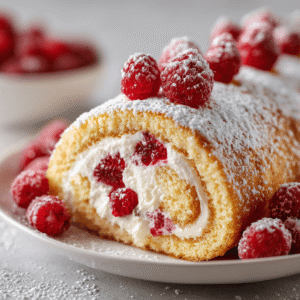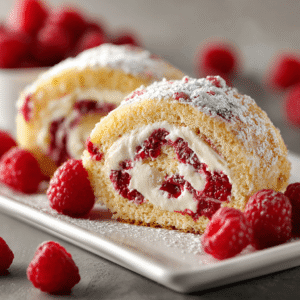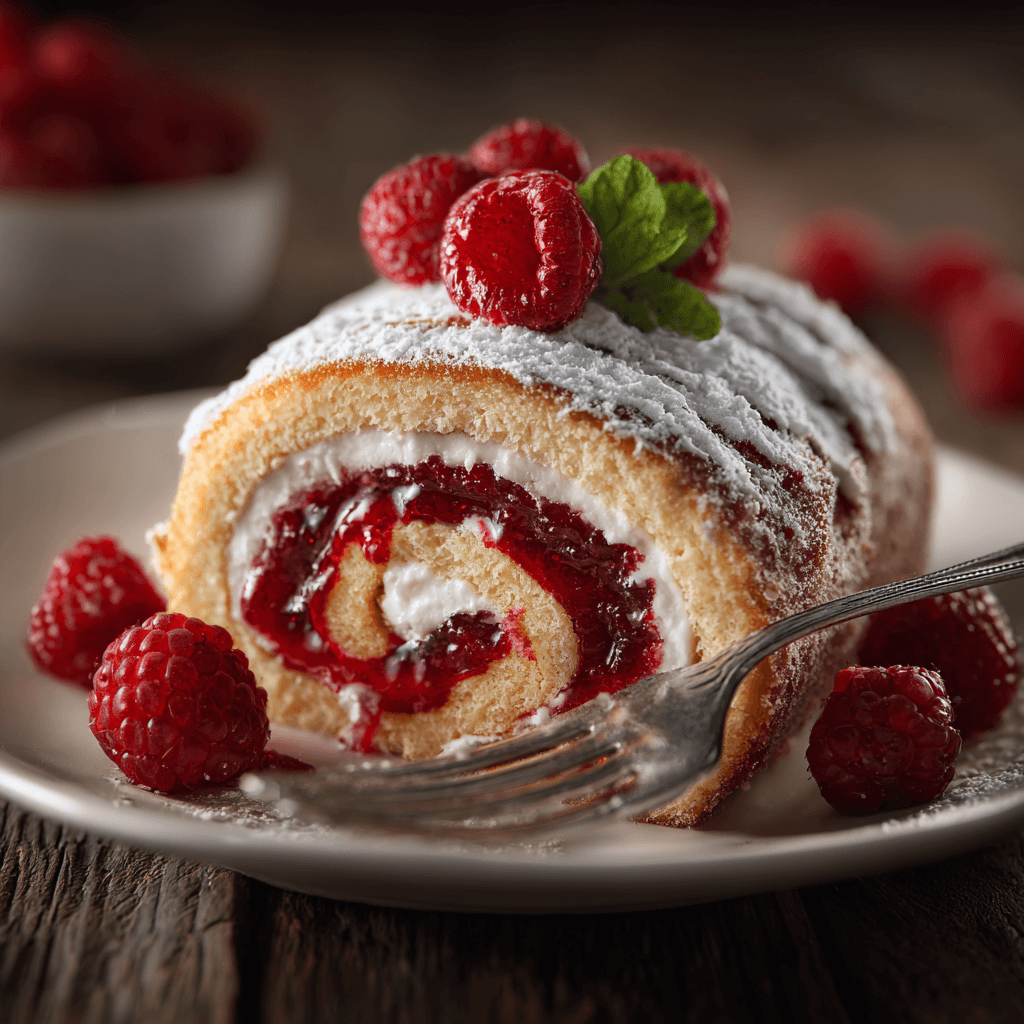“This Raspberry Swiss Roll Recipe is a light and fluffy sponge cake filled with fresh raspberries and cream. Perfect for tea time, holidays, or any special occasion, this rolled cake is as beautiful as it is delicious.”
A beautiful raspberry Swiss roll transforms simple ingredients into an impressive dessert that looks professionally made yet remains surprisingly achievable for home bakers. Moreover, this delicate sponge cake filled with fresh raspberries and whipped cream creates an elegant centerpiece for any gathering. Furthermore, the stunning spiral pattern revealed when sliced makes this dessert as visually appealing as it is delicious.
This raspberry Swiss roll recipe requires intermediate baking skills with a prep time of 30 minutes, baking time of 12 minutes, and assembly time of 20 minutes, serving 8-10 people generously. Additionally, the key to success lies in creating a flexible sponge cake that rolls without cracking and a

fresh fruit filling that complements the delicate cake texture.
What makes this recipe special is the perfect balance of tart raspberries against sweet vanilla sponge, all wrapped in luxurious whipped cream. Consequently, you’ll create a dessert that rivals those found in European patisseries, making it ideal for special occasions, holidays, or whenever you want to showcase your baking prowess to impressed guests.
The Surprising History of Swiss Roll: Not Actually Swiss
The fascinating story behind raspberry Swiss roll reveals that this beloved dessert has nothing to do with Switzerland, despite its name. Interestingly, food historians trace its origins to 19th century Central and Eastern Europe, where rolled cakes first appeared in various forms across different cultures.
The dessert’s journey to America began with European immigrants who brought their baking traditions to the New World. However, the term “Swiss roll” didn’t appear until 1872 in American cookbooks, while earlier references called it “jelly cake” as far back as 1852. The Swiss association likely developed as a marketing term to suggest European sophistication and quality.
Different countries developed their own variations of this rolled cake concept. Moreover, the French created the “roulade,” Italians perfected the “rotolo,” and Germans made “Biskuitrolle.” Each version reflected local preferences for fillings and preparation methods, but all shared the same basic technique of rolling warm sponge cake around sweet fillings.
The raspberry version gained popularity during the Victorian era when fresh berries became symbols of luxury and refinement. Furthermore, the combination of delicate cake with seasonal fruit represented the pinnacle of domestic accomplishment for Victorian hostesses who took pride in elaborate dessert presentations.
Modern Swiss rolls evolved throughout the 20th century as home baking became more accessible. Additionally, the introduction of electric mixers and improved oven technology made the delicate sponge cake more achievable for average home bakers. Today’s raspberry Swiss roll continues this tradition of elegant simplicity, proving that some classic desserts never go out of style.
The cultural significance of rolled cakes extends beyond mere dessert – they represent celebration, hospitality, and the artistry possible in home kitchens when technique meets creativity.
Complete Ingredients for Raspberry Swiss Roll Success
Creating the perfect raspberry Swiss roll requires carefully selected ingredients that work together to achieve the ideal texture, flavor, and rollability. Moreover, each component serves a specific purpose in ensuring your cake rolls smoothly without cracking.
Essential Cake Ingredients
For the Vanilla Sponge Cake:
- 4 large eggs, room temperature
- ⅔ cup granulated sugar
- ⅔ cup all-purpose flour
- 1 teaspoon baking powder
- ¼ teaspoon salt
- 1 teaspoon vanilla extract
- 2 tablespoons whole milk, room temperature
- Powdered sugar for dusting
For the Raspberry Cream Filling:
- 1½ cups heavy whipping cream, cold
- ¼ cup powdered sugar
- 1 teaspoon vanilla extract
- 1½ cups fresh raspberries
- 2 tablespoons granulated sugar
- 1 tablespoon lemon juice

The eggs must be at room temperature for maximum volume when whipped, which is crucial for creating the light, airy texture necessary for successful rolling. Furthermore, use large eggs for consistent results, as the recipe depends on specific proportions for proper structure.
Fresh raspberries work best for this recipe, though frozen raspberries can be substituted if thawed and drained thoroughly. Additionally, the fruit should be gently tossed with sugar and lemon juice to enhance flavor and create natural juices that complement the cream filling.
For ingredient substitutions, cake flour can replace all-purpose flour for an even more tender texture – use ¾ cup cake flour in place of ⅔ cup all-purpose flour. Moreover, those avoiding dairy can substitute coconut cream for heavy cream, though the texture will be slightly different.
Quality matters significantly in this recipe, particularly with the vanilla extract and fresh fruit. Furthermore, pure vanilla extract provides superior flavor compared to imitation versions, while ripe, fragrant raspberries ensure the best taste and appearance in your finished Swiss roll.
Essential Equipment and Pro Baking Techniques
Success with raspberry Swiss roll depends heavily on having the right equipment and mastering specific techniques that prevent common failures like cracking or uneven rolling. Moreover, professional results come from understanding how each tool contributes to the final outcome.
Essential equipment includes a 10×15-inch jelly roll pan (quarter sheet pan), parchment paper, an electric mixer (stand or hand mixer), large mixing bowls, a fine-mesh sieve for dusting, rubber spatula, and clean kitchen towels. Additionally, you’ll need measuring cups, measuring spoons, and a wire cooling rack for proper cake handling.
The most critical technique involves the rolling process itself. Furthermore, the cake must be rolled while still warm to prevent cracking, using a parchment paper-lined towel dusted with powdered sugar. This method allows the cake to “memorize” its rolled shape as it cools, making the final assembly much easier.
Temperature control throughout the process ensures success at every stage. Specifically, room temperature eggs whip to maximum volume, while properly preheated ovens (375°F) create the quick rise necessary for tender sponge cake. Additionally, cooling the cake properly prevents condensation that can make rolling difficult.
Timing coordination becomes crucial with Swiss rolls since several steps must happen in quick succession. Moreover, have all your equipment ready before starting, as the cake needs immediate attention once it comes out of the oven. Prepare your rolling towel with powdered sugar while the cake bakes.
Professional tips include testing egg temperature by touching them – they should feel neutral, not cold. Furthermore, sift the flour mixture twice for the lightest possible texture, and never overmix the batter once flour is added, as this develops gluten and creates a tough cake.
Common mistakes to avoid include letting the cake cool too much before rolling (causes cracks), using too much force when rolling (breaks the cake), and overfilling with cream (makes rolling messy and difficult). Additionally, ensure even spreading of batter in the pan for uniform thickness and consistent rolling.

Step-by-Step Instructions for Perfect Swiss Roll
Creating a flawless raspberry Swiss roll requires precise timing and technique, with each step building toward the final impressive result. Moreover, following this systematic approach ensures consistent success even for intermediate bakers.
Step 1: Prepare Your Workspace (5 minutes) Preheat oven to 375°F and line a 10×15-inch jelly roll pan with parchment paper, leaving slight overhang for easy removal. Furthermore, prepare a clean kitchen towel by laying it flat and dusting generously with powdered sugar through a fine-mesh sieve. Set aside near your workspace for immediate use.
Step 2: Create the Sponge Cake Batter (8-10 minutes) In a large mixing bowl, beat eggs with an electric mixer on high speed for 3-4 minutes until thick, pale, and tripled in volume. Moreover, gradually add granulated sugar while continuing to beat for another 2-3 minutes until the mixture forms ribbons when lifted. In a separate bowl, whisk together flour, baking powder, and salt.
Step 3: Fold and Combine Carefully (3-4 minutes) Sift the flour mixture over the egg mixture in three additions, gently folding with a rubber spatula after each addition. Additionally, combine vanilla and milk in a small bowl, then fold into the batter until just incorporated. Avoid overmixing to maintain the light, airy texture essential for rolling.
Step 4: Bake to Perfection (12-15 minutes) Spread batter evenly in the prepared pan using an offset spatula, ensuring uniform thickness. Furthermore, bake for 12-15 minutes until the cake springs back lightly when touched and edges just begin to pull away from the sides. The surface should be golden and set.
Step 5: Execute the Critical Roll (2-3 minutes) Immediately upon removing from oven, run a knife around edges to loosen. Moreover, quickly invert the cake onto the prepared powdered sugar-dusted towel. Carefully peel away parchment paper, then immediately roll the cake up in the towel, starting from the short end. Cool completely while maintaining the rolled shape.
Step 6: Prepare Raspberry Filling (5 minutes) While cake cools, whip heavy cream with powdered sugar and vanilla until soft peaks form. Additionally, gently fold in raspberries that have been tossed with granulated sugar and lemon juice. Avoid overwhipping the cream, as it can become grainy.
Step 7: Final Assembly (5-8 minutes) Carefully unroll the cooled cake and spread raspberry cream evenly, leaving a 1-inch border on all sides. Moreover, re-roll the cake without the towel, starting from the same short end, using gentle pressure to maintain shape. Wrap in plastic wrap and refrigerate for at least 2 hours before slicing.
Visual cues for success include a cake that feels springy to touch when done and cream that holds soft peaks without appearing grainy or overwhipped.
Creative Serving Ideas and Seasonal Variations
Raspberry Swiss roll offers countless opportunities for customization and elegant presentation that can adapt to any season or special occasion. Moreover, these variations keep this classic dessert exciting while maintaining its fundamental appeal.
For stunning presentation, dust the finished roll with powdered sugar and garnish with fresh raspberries and mint leaves. Furthermore, slice with a sharp serrated knife using a gentle sawing motion to reveal the beautiful spiral pattern without compressing the delicate cake structure.
Seasonal adaptations make this recipe year-round appropriate. Additionally, summer versions can incorporate mixed berries or stone fruits like peaches or apricots. Fall variations might include spiced pears with cinnamon cream, while winter holidays call for cranberries with orange zest in the filling.
Flavor variations expand the recipe’s appeal significantly. Moreover, chocolate Swiss rolls use cocoa powder replacing ¼ cup of flour, while lemon versions add lemon zest to both cake and filling. Coffee lovers can enjoy espresso-flavored cream with chocolate cake for an elegant tiramisu-inspired dessert.
Professional plating techniques elevate the dining experience considerably. Furthermore, serve individual slices on chilled plates with raspberry coulis drizzled artistically around the plate. Add a small quenelle of vanilla ice cream or fresh whipped cream for restaurant-quality presentation.
Beverage pairings complement the delicate flavors beautifully. Additionally, serve with champagne or prosecco for celebrations, earl grey tea for afternoon service, or dessert wines like Moscato d’Asti. Coffee pairs wonderfully with chocolate variations, while herbal fruit teas enhance berry versions.
Make-ahead strategies allow stress-free entertaining since Swiss rolls actually improve after overnight refrigeration as flavors meld. Moreover, the dessert can be completely assembled up to two days in advance, making it perfect for dinner parties where timing matters.
For special occasions, create mini Swiss rolls using a smaller pan and cutting into individual portions, or make a Swiss roll trifle by layering cake pieces with cream and berries in a glass bowl for dramatic visual impact.
Storage Guidelines and Food Safety Tips
Proper storage of raspberry Swiss roll maintains both quality and safety while preserving the delicate texture and fresh fruit flavors. Moreover, following these guidelines ensures your dessert remains at peak condition throughout its storage period.
Refrigeration is essential due to the fresh dairy cream and fruit components. Furthermore, wrap the completed Swiss roll tightly in plastic wrap and store in the refrigerator immediately after assembly. Properly stored, it maintains optimal quality for 2-3 days, though texture is best within the first 24-48 hours.
For optimal freshness, place the wrapped roll in an airtight container to prevent absorption of refrigerator odors that can affect the delicate flavors. Additionally, store away from strong-smelling foods and ensure consistent refrigerator temperature below 40°F for food safety compliance.
Freezing extends storage up to one month, though texture changes occur upon thawing. Moreover, wrap individual slices tightly in plastic wrap, then place in freezer bags with air removed. Thaw slowly in the refrigerator overnight, never at room temperature, to maintain food safety.
Transportation considerations include using insulated coolers with ice packs for events or potlucks. Furthermore, keep the dessert level during transport to prevent shifting of the filling, and minimize time outside refrigeration to maintain both quality and safety.
Food safety protocols require keeping the dessert refrigerated until 30 minutes before serving to allow slight tempering for optimal flavor. Additionally, use clean utensils when serving to prevent cross-contamination, and return leftovers to refrigeration promptly.
Signs of spoilage include off odors, visible mold, or separation of the cream filling. Moreover, fresh fruit components are particularly susceptible to spoilage, so monitor carefully and discard if any questionable changes occur. When in doubt about freshness, err on the side of caution and discard the dessert.
Conclusion: Master This Impressive Dessert Technique
This raspberry Swiss roll recipe represents the perfect balance of technique and creativity, offering home bakers the opportunity to create truly impressive desserts with achievable methods. Moreover, mastering this recipe opens doors to countless variations and seasonal adaptations that will keep your dessert repertoire fresh and exciting.
The combination of delicate sponge cake technique with fresh fruit flavors creates a dessert that’s both elegant and approachable. Furthermore, once you’ve mastered the rolling technique, you’ll find this becomes one of your most requested recipes for special occasions and gatherings.
What’s your experience with rolled cakes, and which fruit combination would you most like to try in a Swiss roll? Additionally, have you discovered any techniques that help prevent cracking when rolling delicate cakes? Share your baking experiences and tips in the comments to help fellow home bakers master this beautiful dessert.
Remember to share photos of your raspberry Swiss roll creations on social media – the beautiful spiral pattern makes for stunning food photography that’s sure to impress your followers!
Recipe Card
Perfect Raspberry Swiss Roll
- Prep Time: 30 minutes
- Bake Time: 12-15 minutes
- Assembly Time: 20 minutes
- Total Time: 1 hour 5 minutes
- Servings: 8-10 slices
- Difficulty: Intermediate
Ingredients
For the Sponge Cake:
- 4 large eggs, room temperature
- ⅔ cup granulated sugar
- ⅔ cup all-purpose flour
- 1 teaspoon baking powder
- ¼ teaspoon salt
- 1 teaspoon vanilla extract
- 2 tablespoons whole milk, room temperature
- Powdered sugar for dusting
For the Raspberry Filling:
- 1½ cups heavy whipping cream, cold
- ¼ cup powdered sugar
- 1 teaspoon vanilla extract
- 1½ cups fresh raspberries
- 2 tablespoons granulated sugar
- 1 tablespoon lemon juice
Instructions
- Preheat oven to 375°F, line jelly roll pan with parchment
- Prepare powdered sugar-dusted towel for rolling
- Beat eggs until thick, gradually add sugar
- Fold in flour mixture, then vanilla and milk
- Spread in pan, bake 12-15 minutes until springy
- Immediately roll in towel, cool completely
- Whip cream with powdered sugar and vanilla
- Fold in sugared raspberries
- Unroll cake, spread filling, re-roll without towel
- Refrigerate 2+ hours before slicing
Nutrition (per slice)
- Calories: 185
- Fat: 9g
- Carbohydrates: 24g
- Protein: 4g
- Sugar: 19g
Recipe Notes
- Roll cake while warm to prevent cracking
- Can be made 2 days ahead
- Use gentle sawing motion when slicing
- Store refrigerated, covered
Internal Linking Opportunities:
- Link to “Essential Baking Equipment Guide”
- Link to “Sponge Cake Techniques”
- Link to “Seasonal Fruit Desserts”
- Link to “Professional Cake Decorating Tips”
